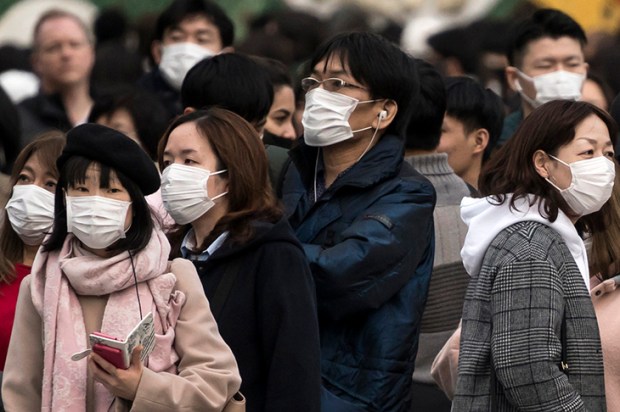So are we all going to die or is it going to fizzle out? In Naples the police drive along streets with loudhailers, warning everyone to keep indoors; in Britain the government declines to close schools, call off sporting fixtures and persuade people out of the pub. Something feels not quite right: either there is huge overreaction or under-reaction to Covid-19. Health Secretary Matt Hancock has not helped calm fears by announcing that the government has been working on a worst-case scenario of 80 per cent of the population catching the virus and 500,000 dying from it.
It isn’t easy for the scientists, either. In a fast-developing disease there is, inevitably, a shortage of up-to-date, peer-reviewed studies to give you an accurate picture. But from what we do have so far, this is what we can tell about coronavirus Covid-19.
Firstly, how many of its victims does it kill? You may well have heard the figure of 3.4 per cent reported over the past week. This came from an announcement by the World Health Organisation (WHO) and was widely reported as evidence that the disease is more deadly than previously imagined, given that previous estimates had put the mortality rate at 1 to 2 per cent. What the WHO was at pains to explain was that the 3.4 per cent is simply the number of deaths divided by the number of reported cases, known as the Case Fatality Rate (CFR). What it doesn’t do is account for the possibility that there may be many more people who have been infected with the virus who have gone unrecorded, most likely because their symptoms have been so mild that they have not sought treatment.
Two studies have tried to estimate how many infected people will go on to die from the disease. A team at Imperial College looked at the results of coronavirus tests performed on nearly 1,000 citizens who were flown to their home countries on repatriation flights from China, and used this to estimate the extent of under-reporting of the virus in Hubei province. They were able to estimate an overall Infection Fatality Rate (IFR) of 0.9 per cent — with a range of uncertainty between 0.37 per cent and 2.9 per cent. The Institute for Disease Modeling, based in Washington state, performed the same exercise and came up with a very similar number: an IFR of 0.94 per cent (with a range of uncertainty between (0.5 per cent and 4 per cent). The latter study also measured a sharply rising death rate with age.
But how likely are you to catch the disease in the first place? Is it remotely possible that 80 per cent of us will go down with it? The best guide we have to the virus’s ability to spread is a study from the Shenzhen Centre for Disease Control and the John Hopkins Bloomberg School of Public Health. It has not yet been peer-reviewed but, thanks to the importance of the subject, has been pre-published. It looked at a total of 1,286 people who were in close contact with coronavirus sufferers in Shenzhen, a city adjoining Hong Kong. The study found that 14.9 per cent of people who shared a room or apartment with a coronavirus sufferer went on to contract the infection themselves. Of those who had close contact with a sufferer outside the home, 9.6 per cent went on to become infected. There were, however, some missing results from the study. If these people were included, and assumed not to have contracted the virus, the infection rate fell to 11.2 per cent for people who shared households with an infected person and 6.6 per cent who had close contact outside the home. Children were found to have a slightly lower risk of picking up the infection, but not by much. They were, however, found to have less severe symptoms than adults.
Finally, how many people in the world are really infected with Covid-19? The WHO produces a daily situation report on the virus. The report for Tuesday, for example, showed that 109,577 globally have been confirmed as being infected, a rise of 3,993 on the day before. There are 80,904 confirmed cases in China, 7,382 in South Korea, 7,375 in Italy and so on. But for reasons given above, this is likely to be only the tip of the iceberg, as many people who have contracted the disease will have such minor symptoms that they have not come into contact with healthcare services. Many might even be unaware they have the disease. Whether we can trust the data reported by China and other countries is another matter.
But two peer-reviewed studies have attempted to quantify the size of the iceberg itself. They did this by looking at the numbers of people who had travelled out of Hubei province by aircraft and gone on to spread the disease elsewhere. If, for example, it takes 5,000 plane passengers to travel between Wuhan and Bangkok before a case of Covid-19 pops up in the latter city, that gives a clue to how many people in Wuhan might have the disease. A team at the University of Austin, Texas, for example, estimated the number of people likely to have been infected with Covid-19 in Wuhan by 22 January as 11,213 (with a range between 1,590 and 57,087). On that day, the WHO put the number of recorded cases in the whole of Hubei province at just 270. A University of Hong Kong study produced an estimate for the number of infected people in Wuhan on 25 January at 75,815 (range 37,304 to 130,330). On that day the WHO put the number of reported cases in the whole of China at just 1,297.
That is what evidence we have so far: an infection that is likely to be far more widespread than officially reported figures suggest, yet neither as contagious nor as deadly as many fear. You can decide yourself how worried you should be.
Got something to add? Join the discussion and comment below.
Get 10 issues for just $10
Subscribe to The Spectator Australia today for the next 10 magazine issues, plus full online access, for just $10.
You might disagree with half of it, but you’ll enjoy reading all of it. Try your first month for free, then just $2 a week for the remainder of your first year.















Comments
Don't miss out
Join the conversation with other Spectator Australia readers. Subscribe to leave a comment.
SUBSCRIBEAlready a subscriber? Log in